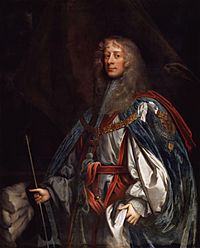Second Ormonde Peace facts for kids

The Second Ormonde Peace was a peace deal and team-up signed on January 17, 1649. It was made between the Marquess of Ormonde, who led the King's supporters in Ireland, and the Irish Confederates, who were Irish Catholic leaders.
This agreement brought together groups who used to be enemies. It united Protestants and Catholics from Ireland, Scotland, and England. These were the three kingdoms ruled by King Charles I. At the time, King Charles I was a prisoner of the Puritan London Parliament.
When King Charles I was executed on January 30, 1649, everyone who signed the treaty decided to support his young son, Charles II. Most Catholics in Ireland liked the deal. They believed their earlier uprising had been approved by the old King.
However, Owen Roe O'Neill and his Ulster Army did not agree with the peace. Instead, they briefly teamed up with the English Parliament's forces. They helped free the Parliament's soldiers who were trapped in Derry. After this temporary agreement ended, O'Neill's forces changed sides.
The combined forces of this new alliance were later defeated. This happened during the strong takeover of Ireland by Oliver Cromwell. Ireland then came under the control of the Parliament until the King was brought back in 1660. Some soldiers who survived and stayed loyal to Charles II later served in his army while he was in exile.
Contents
Why the Peace Treaty Happened
Ireland's Troubles Begin
The Catholic Confederates said they were loyal to King Charles I. But after the 1641 Rebellion, they took control of many strongholds in Ireland. They also tried to get special agreements from the government.
Meanwhile, a Civil War broke out in England. This war was between the King and his opponents. In 1643, a truce was made with the Confederates. It was called the Cessation of Arms. This truce allowed Anglo-Irish Royalist troops to leave Ireland and fight in the English Civil War.
Earlier Peace Attempts
After long talks, the First Ormonde Peace was agreed upon in 1646. This was between the King's representative and the Irish Confederates. However, this agreement caused a civil war among the Catholics in Ireland. There were two groups: those who supported the treaty and those who did not.
Owen Roe O'Neill, a former soldier from Spain, led the Ulster Army. He joined the forces that were against the treaty. This stopped the agreement from being put into action.
King Charles I's Problems
At the same time, King Charles I's situation in Britain got worse. He gave himself up to the Scottish Covenanters in 1646. They then handed him over to the English Parliament's forces.
By late 1648, the Irish Catholics, the Royalists, and the Scottish Covenanters all saw the London Parliament as their biggest threat. King Charles I's supporters were defeated in the Second English Civil War. Soon after, the English Parliament executed King Charles I. They declared that both England and Ireland would be a republic, meaning they would have no king.
What Happened After the Treaty

In Ulster, O'Neill moved to help Charles Coote's soldiers. They were trapped in Derry. Meanwhile, the allies took control of many towns and cities across Ireland. Ormonde's troops then moved to attack the capital city, Dublin.
However, even before Oliver Cromwell's extra soldiers arrived, his local Irish commander, Michael Jones, defeated the allied forces. This happened at the Battle of Rathmines. Cromwell then began his own attacks. He stormed Drogheda and then Wexford.
In the north, the Catholic Ulster Army now switched sides to join the other allies. But they were completely defeated at the Battle of Scarrifholis. The Scottish Covenanter Army in the North had already been crushed at the Lisnagarvey.
Ormonde left Ireland and gave command to the Catholic Royalist Lord Clanricarde. But organized fighting mostly stopped after the loss of Galway. Any further resistance was mainly done through small, hidden attacks.
Ormonde and some important Irish Catholics went into exile. A number of soldiers went with them. Four regiments that fought at the Battle of the Dunes were made up of former members of the 1649 allied forces. They also had new recruits from Ireland.
Ormonde was eventually brought back as Lord Lieutenant. Many Catholics successfully asked the Court of Claims to get their land back. This land had been taken by Cromwell because they had served in the Royalist alliance.

